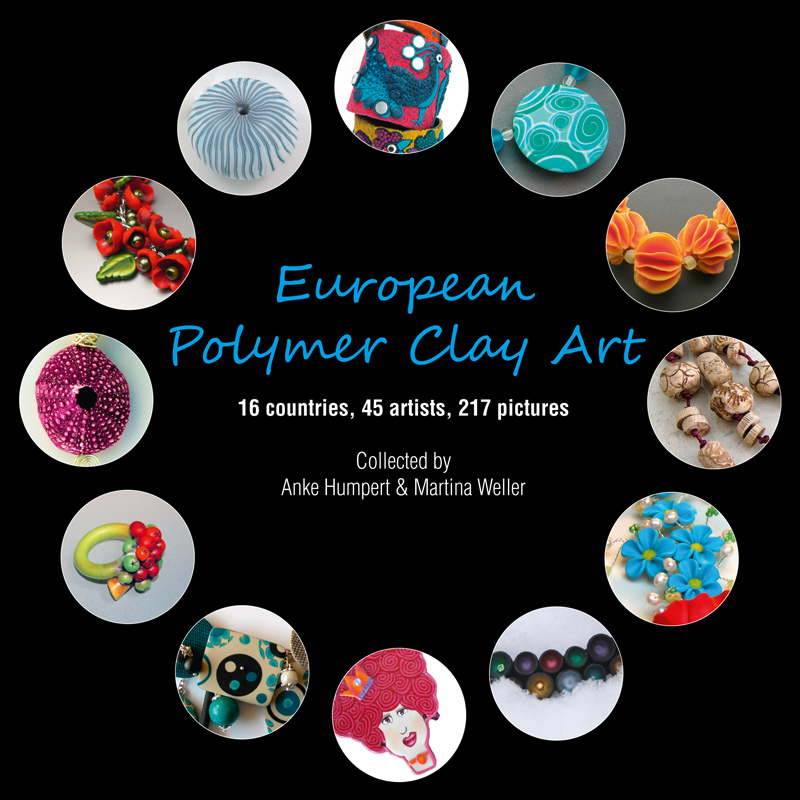Testing ChameleonTM Pens and Polymer Clay - Varnishes
After my blog post about the use of Chameleon Pens on polymer clay (if you missed that post you can read up on it here ) I got a couple of questions about the use of varnish on the finished pieces. I had to admit I did not know if any varnish would affect the surface of the painted clay and so it naturally lead to more testing! So today I would like to share my results of my tests with you.
This was my set up:
I rolled out 3 squares
of Sculpey Soufflé Igloo (my preferred surface for the use of ChameleonTM
Pens) and stamped them with a stamp with lots of details. I used a stamp from
EfCo. It is called “Texture Mat Moments”, just in chase you were interested,
and I used a black “Archival ink” stamp
pad from Ranger with it.
After stamping I cured
all 3 test tiles for 30 minutes at 275°F/130°C. After they have cooled down
completely they were ready to be painted with the ChameleonTM Pens.
I use a wide variety of colours and blends to see how they would react. In my
experience sometimes only one color of a color combination can be difficult
with a certain material or varnish, so it is best to have a wide choice for
testing.
1 Fimo – Semi Gloss Varnish (by
Staedtler)
2 Fimo – Gloss Varnish (by
Staedtler)
3 Lisa Pavelka´s Magic GlosTM
4
Sculpey´s – Gloss Glaze
5 Ranger´s Glossy AccentsTM
6
Judy Kins´ – DG3 Art Gel
7 MP-Multimedia Spray Varnish (this
is a German product that is similar to PYM II , which I can not easyly get hold of here in Germany. I can not garenty it is
exactly the same, but I asume it will give similar results)
Having 9 different varnishes, I cut
my testing tiles in 4 quarters to have enough pieces for the varnishes, plus
three to be untreated for comparing my tests.
I have some glossy and some matt
varnishes, so I expected them to look quite different. Also not all of them
require the same way of treatment. So first I will list each single one of the
varnishes I tested and finally I will give you my personal results from this
test:
1 Fimo – Semi Gloss Varnish (by Staedtler)
I applied the varnish with a small
brush. It need to be shaken before use and can be cleaned with water. I added
one layer for all my test, so I could compare all varnishes. This varnish has
to dry for 24 hours.
The description says the varnish is
semi gloss, but I actual find in not very glossy at all. Not even semi. The
good thing is that all the colors were not altered by the varnish and it does
make the surface a bit smoother than without varnish. So I think it can be used
as a coat of protection, when you do not really want to change the look of the
original piece.
2 Fimo – Gloss Varnish (by Staedtler)
This varnish comes with a little
brush in the bottle (only for the small size I had) and it is also water-based.
It does look a tiny bit more glossy than the semi gloss varnish, I tried
before. But with one layer this is hardly recognizable. It might be different
if you apply more layers.
Everything else is quite the same as
with the gloss varnish of the same make: no color change visible. Needs to dry
for 24 hours. Makes the surface a bit smoother than without varnish.
3 Lisa Pavelka´s Magic GlosTM
Magic GlosTM was
the first disappointment in my tests: it did change the colors quite a bit.
Especially the reds. Also it bend the thin polymer clay base and so the varnish
had spots, were the varnish did flow off and leave places without much varnish
on them, that do not look good.
I applied it and left it
to dry together with the other pieces, but I did not like the color change at
all. So no recommendation for this varnish from me.
4
Sculpey´s – Gloss Glaze
Sculpey´s Gloss Glaze is easy to be
applied with a small brush. The label says that you should NOT shake it before
use (because that will create bubbles in your varnish!) and it can be cleaned
up with water and soap. Easy peasy! It dyes completely in 24 hours like the
other varnishes I used. And this varnish does have a gloss, like it says on the
label! Even with one coat it gives a nice shiny surface, but it is not covering
the texture from the stamp impression up. I really like that!
There is no color change or
anything. So if you want a little shine and some protection for your pieces,
this is a definite option for you!
Unfortunately I did not have any
Sculpey´s Satin Glaze to try out, but as soon as I have some I will definitely add it to my tests!
5 Ranger´s Glossy AccentsTM
This varnish is similar to Magic
Gloss, but with two big differences: it does NOT change the colors and it
covers the clay completely! Dont shake the bottle (to prevent bubbles to appear
in you glaze!) and it is a bit hard to squeeze the bottle to get the varnish
out. It is rather thick and forms a thick layer on top of your clay. But you
can easily see were you missed a place and so the varnish does cover the whole
area, when applied properly.
Just like the Magic GlossTM it
does bend a thin sheet of clay a little. If you are aiming for a thick glass
like surface, this is the varnish I would recommend!
6 Judy Kins´ – Diamond Glaze 3 Art Gel
Judy Kins´Diamond Glaze is another
one of the very thick and shiny varnishes. It is applied similar to Magic GlossTM
with squeezing it out of the bottle, which can be quite hard
at times. It is not quite as thick as Magic GlossTM though and you
have to be careful to apply it to all places on you clay tile! I missed a
couple of them in my test.
What is better with Diamond Glaze is
that it does not bend the thin clay at all! This is definitely a point to take
into consideration, if you what to choose the right varnish to have a thick
glass like finish for your pieces. And Diamond Glaze also does not change the
Chameleon PenTM colors at all. So I would recommend Diamond Glaze as
a very close second to Magic GlossTM.
The effect of the spray gives a
shine, but not quite as smooth at the Fimo Gloss Glaze, because it is difficult
to apply it very evenly with the spray. It dries, like all the other best over
night and it does not affect the colors.
8 Golden Varnish – Polymer Varnish with
UVLS (gloss)
The Golden Varnish (gloss) needs to
be diluted before applying it with a brush. The label suggests 4 parts varnish
to 1 part water. After mixing the dilution it is easily applied with a brush.
This varnish can be heat set after it is applied. I did that for about 20
minutes at at 275°F/130°C.
The Golden Varnish (Gloss) gives a
nice shine without overdoing it. No effect on the colors at all. And it is
barely recognizable that there is a varnish on the clay at all. Something I do
like a lot.
Here is also no change of color to
be seen. I really liked the way this tile turned out!
The following pictures are all from
the test tiles with the varnishes on.
In conclusion I can not recommend
Magic GlosTM, because of the color change it causes. All other
varnishes are good to use, but it depends on the effect you are looking for.
If you want a shiny glass like
finish I would go for Gloss Accent or as a second choice Diamond Glaze.
For a shiny surface without a thick
glass like layer I would recommend Sculpey´s Gloss Glaze.
And for matt surface I would use
Golden Varnish (matt).
All these are good choices to
protect your Chameleon PensTM on polymer clay.
For more
information about the Chameleon PensTM take a look at their website.
If you have any questions or like to share your own tips, please let us all know and share in the comments below!
Labels: 2015, Anke Humpert, Chameleon Pens, mixed media art, Sculpey, studio, testing, varnish












































2 Comments:
I would add "Preserve Your Memories II" spray to your list. It is less available (usually mail order). I've had very good luck with it over various types of ink.
Thank you for your input! Unfortunately it is not possible to get the "Preserve your Memory II" spray (or PYM II) in Germany at the moment. That´s why I used a similar spray that I can get hold of... ;-) I know my list is not covering EVERY thing, but I think it is a good starting point, dont you think? ;-)
Anke
Post a Comment
<< Home